I have data from an experiment with two conditions (dichotomous IV: 'condition'). I also want to make use of another IV which is metric ('hh'). My DV is also metric ('attention.hh'). I've already run a multiple regression model with an interaction of my IVs. Therefore, I centered the metric IV by doing this:
hh.cen <- as.numeric(scale(data$hh, scale = FALSE))
with these variables I ran the following analysis:
model.hh <- lm(attention.hh ~ hh.cen * condition, data = data)
summary(model.hh)
The results are as follows:
Coefficients:
Estimate Std. Error t value Pr(>|t|)
(Intercept) 0.04309 3.83335 0.011 0.991
hh.cen 4.97842 7.80610 0.638 0.525
condition 4.70662 5.63801 0.835 0.406
hh.cen:condition -13.83022 11.06636 -1.250 0.215
However, the theory behind my analysis tells me, that I should expect a quadratic relation of my metric IV (hh) and the DV (but only in one condition).
Looking at the plot, one could at least imply this relation:
Of course I want to test this statistically. However, I'm struggling now how to compute the lineare regression model.
I have two solutions I think that should be good, leading to different outcomes. Unfortunately, I don't know which is the right one now. I know, that by including interactions (and 3-way interactions) into the model, I also have to include all simple/main effects as well.
- Solution: Including all terms on their own:
therefore I first compute the squared IV:
attention.hh.cen <- scale(data$attention.hh, scale = FALSE)
now i can compute the linear model:
sqr.model.1 <- lm(attention.hh.cen ~ condition + hh.cen + hh.sqr + (condition : hh.cen) + (condition : hh.sqr) , data = data)
summary(sqr.model.1)
This leads to the following outcome:
Call:
lm(formula = attention.hh.cen ~ condition + hh.cen + hh.sqr +
(condition:hh.cen) + (condition:hh.sqr), data = data)
Residuals:
Min 1Q Median 3Q Max
-53.798 -14.527 2.912 13.111 49.119
Coefficients:
Estimate Std. Error t value Pr(>|t|)
(Intercept) -1.3475 3.5312 -0.382 0.7037
condition -9.2184 5.6590 -1.629 0.1069
hh.cen 4.0816 6.0200 0.678 0.4996
hh.sqr 5.0555 8.1614 0.619 0.5372
condition:hh.cen -0.3563 8.6864 -0.041 0.9674
condition:hh.sqr 33.5489 13.6448 2.459 0.0159 *
---
Signif. codes: 0 ‘***’ 0.001 ‘**’ 0.01 ‘*’ 0.05 ‘.’ 0.1 ‘ ’ 1
Residual standard error: 20.77 on 87 degrees of freedom
Multiple R-squared: 0.1335, Adjusted R-squared: 0.08365
F-statistic: 2.68 on 5 and 87 DF, p-value: 0.02664
Solution: R includes all main effects of an interaction by using the *
sqr.model.2 <- lm(attention.hh.cen ~ condition * I(hh.cen^2), data = data)
summary(sqr.model.2)
IMHO, this should also be fine -- however, the output is not the same as the one received by the code above
Call:
lm(formula = attention.hh.cen ~ condition * I(hh.cen^2), data = data)
Residuals:
Min 1Q Median 3Q Max
-52.297 -13.353 2.508 12.504 49.740
Coefficients:
Estimate Std. Error t value Pr(>|t|)
(Intercept) -1.300 3.507 -0.371 0.7117
condition -8.672 5.532 -1.567 0.1206
I(hh.cen^2) 4.490 8.064 0.557 0.5791
condition:I(hh.cen^2) 32.315 13.190 2.450 0.0162 *
---
Signif. codes: 0 ‘***’ 0.001 ‘**’ 0.01 ‘*’ 0.05 ‘.’ 0.1 ‘ ’ 1
Residual standard error: 20.64 on 89 degrees of freedom
Multiple R-squared: 0.1254, Adjusted R-squared: 0.09587
F-statistic: 4.252 on 3 and 89 DF, p-value: 0.007431
I'd rather go with solution number 1 but I'm not sure about that.
Maybe someone has a better solution or can help me out?
